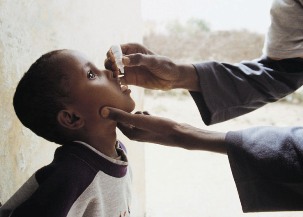 More than 3.2 million children under the age of five are being immunized against polio in South Sudan In many countries of the Eastern Mediterranean Region, delivering immunization services is not an easy task. Demographic, geographic, social and economic challenges, in addition to limited health system capacities, often affect the delivery of such services. When delivering immunization services in countries facing emergencies, the process becomes even more challenging as the risks become greater.
More than 3.2 million children under the age of five are being immunized against polio in South Sudan In many countries of the Eastern Mediterranean Region, delivering immunization services is not an easy task. Demographic, geographic, social and economic challenges, in addition to limited health system capacities, often affect the delivery of such services. When delivering immunization services in countries facing emergencies, the process becomes even more challenging as the risks become greater.
Somalia, Iraq and South Sudan are just three countries in the Region that are currently facing security risks. Despite the obstacles involved, WHO and local health staff work hard to reach populations living in affected areas who need vaccinations the most.
Mohamed Abdullahi, the immunization focal person for central Somalia, wakes up every morning to the sounds of explosions and gun fire. For more than 20 years, war-torn Mogadishu has been occupied by warlords, fundamental religious leaders and a number of foreign fighters. The city has known three successive governments and more recently, the country has also faced one of the worst famines in years.
Moving from one place to another in Mogadishu is difficult and dangerous, so organizing vaccination activities is risky. The late Minister of Health was killed during a medical school graduation ceremony, and there have been explosions in football fields and at the national theatre. “Everybody is afraid of coming together in a group, yet we come together,” said Mohamed. “In 2010, we launched the first WHO Vaccination Week in Somalia. We had a similar feeling of unease in 2011, but again we made it. We will also make it this time,” says Mohamed, who was committed to making Vaccination Week 2012 a reality in war-torn Mogadishu.
Despite the risks, in 2011 vaccinators in Somalia were able to reach and vaccinate 817 496 children under the age of 5 against measles and polio in a two-week period. “We understand the risks, but we also believe that we need to deliver immunization services to save the lives of our children,” said Mohamed.
Vaccinators in countries facing emergencies also sometimes find themselves in positions where they have to go beyond their usual responsibilities to help those in need.
In Iraq, a team of vaccinators in the Missan governorate noticed smoke emerging from one of the isolated houses in the countryside during their visit. When they moved closer to the source of the smoke, they discovered that fire had erupted in the house, with the family trapped inside. Without any hesitation, the vaccinators passed through the fire line and rescued the children and their mother.
In Nasria governorate, another mobile vaccination team was vaccinating babies when they noticed that one of the mothers, a pregnant women, was going into labour. One of the female vaccinators intervened and helped to deliver a beautiful girl, who was named Rajaa, after the vaccinator.
Despite these unexpected interruptions, however, in 2011 vaccinators in Iraq managed to make sure that at least 50% of parents and caretakers of under-vaccinated children in low-coverage areas became aware of the importance of immunization schedule completion.
In South Sudan, reaching every child is a huge challenge due to insecurity, a mobile migrant population and geographical challenges, such as rain and bad roads. Despite these obstacles, WHO, the Ministry of Health and UNICEF have launched a “Kick polio out of South Sudan” campaign that aims to target over 3.2 million children under the age of five in all 10 states of South Sudan through house-to-house immunization calls.
With this in mind, being a vaccinator means being well-organized,a good communicator, and having the tenacity to track down every last child. One vaccinator from Western Equatoria-Tambura County overcomes geographical obstacles by riding a bicycle to reach children in need of vaccinations. “The only way I can reach all of the children in my areas according to the daily itinerary movement plan made by the team supervisor is to use my bicycle. This is because the distances are far apart and there is no road for a vehicle, except only a foot path. Sometimes I go on foot because some areas are impassable using a bicycle,” she said.


